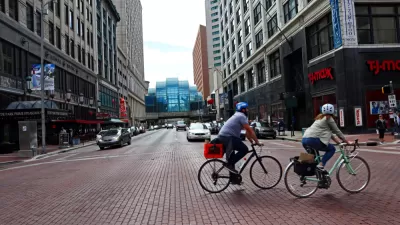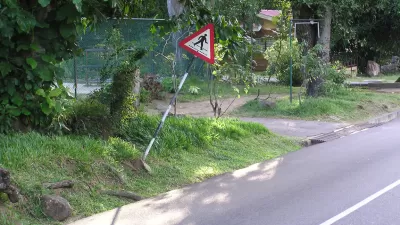The IndyStar shines a light on the city of Indianapolis' neglect of its infrastructure.

A feature article by John Tuohy and Tony Cook documents the consequences of a decision to stop installing streetlights in Indianapolis, made by the city's leaders 35 years ago. The article starts with the tragic story of Amohd Welbon-Cook, when the driver of a blue Chevrolet Avalanche struck and killed him on an unlit stretch of stretch of Georgetown Road.
In other cities, the motorist might have noticed a pedestrian walking along a busy, high-speed street such as Georgetown Road because it likely would have been illuminated by the most basic of city services — a streetlight.
Compounding the public safety problems presented by the city's lack of streetlights, according to Tuohy and Cook, is the city's lack of sidewalks. In sum, Indianapolis is lacking the infrastructure to make for safe pedestrian mobility.
An IndyStar investigation found that 585 pedestrians have been killed in Marion County since the streetlight ban in 1980. Last year, 27 pedestrians were run down, more than in any year since the moratorium started.
According to the article, the lack of pedestrian infrastructure highlights a failure of priorities in the city. While pedestrian safety suffered for lack of decent infrastructure, "billions of dollars flowed to grand Downtown developments, generally celebrated by politicians, the business community and the media as improvements to the city’s quality of life."
The long-read, feature-length article provides more anecdotes and historic examples of the impact of the city's lack of infrastructure. The article also details the financial and political history behind the decision to stop installing streetlights.
For more reading on the subject, Planetizen noted back in June that the city began installing new streetlights for the first time in 35 years. Aaron Renn also offers his perspective on the city's lack of pedestrian infrastructure, describing the situation as a symptom of a much larger problem with streets and alleys around the city.
FULL STORY: Left in the dark: Indy's deadly streets

Maui's Vacation Rental Debate Turns Ugly
Verbal attacks, misinformation campaigns and fistfights plague a high-stakes debate to convert thousands of vacation rentals into long-term housing.

Planetizen Federal Action Tracker
A weekly monitor of how Trump’s orders and actions are impacting planners and planning in America.

In Urban Planning, AI Prompting Could be the New Design Thinking
Creativity has long been key to great urban design. What if we see AI as our new creative partner?

King County Supportive Housing Program Offers Hope for Unhoused Residents
The county is taking a ‘Housing First’ approach that prioritizes getting people into housing, then offering wraparound supportive services.

Researchers Use AI to Get Clearer Picture of US Housing
Analysts are using artificial intelligence to supercharge their research by allowing them to comb through data faster. Though these AI tools can be error prone, they save time and housing researchers are optimistic about the future.

Making Shared Micromobility More Inclusive
Cities and shared mobility system operators can do more to include people with disabilities in planning and operations, per a new report.
Urban Design for Planners 1: Software Tools
This six-course series explores essential urban design concepts using open source software and equips planners with the tools they need to participate fully in the urban design process.
Planning for Universal Design
Learn the tools for implementing Universal Design in planning regulations.
planning NEXT
Appalachian Highlands Housing Partners
Mpact (founded as Rail~Volution)
City of Camden Redevelopment Agency
City of Astoria
City of Portland
City of Laramie





























